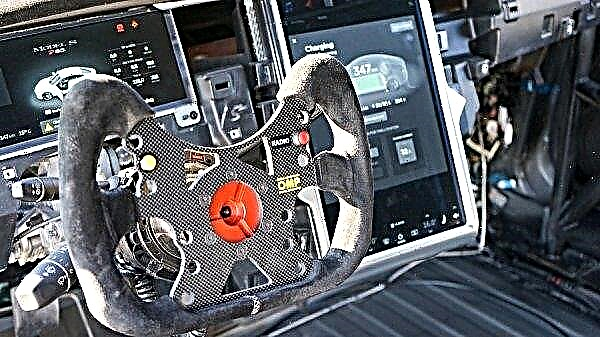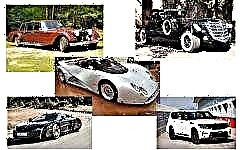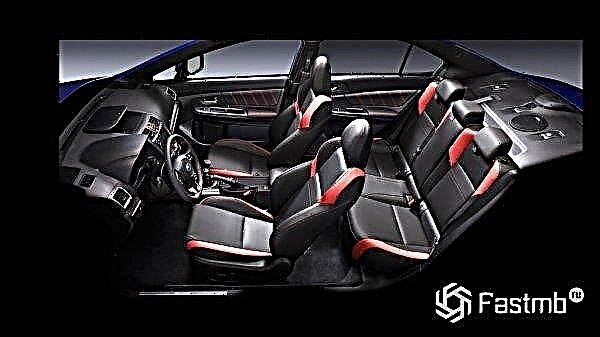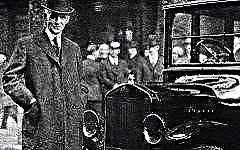

The content of the article:
- Mass entertainer
- Cars color - black
- Millionaire millionaire
- "Right on time"
- Triple safety
- The fastest
- Pioneer testers
- Ford and ABS
- Mein Kampf
- The car that changed the world
In 2019, Ford Motor Company celebrates 116 years of its existence, during which the company has established itself as a pioneer in the auto industry. Some interesting facts and cars of this iconic brand are in our review.
1. Mass entertainer

Already in 1927, Ford had sold more than 16 million units, which was a fantastic figure at the time.
Thanks for such results follows the continuous assembly line that Henry Ford introduced at his plant for the mass production of Model T.
For 1913, this was a kind of industrial revolution, because it was from this line that mass production began throughout the rest of the world at the Highland Park plant in Michigan.
Henry Ford initially set the task of producing mass-produced cars that are simple, reliable and cheap, so that everyone can afford them. Thus, Ford decided to "put the world on wheels", for which it was required to simplify the procedure for assembling the car.
In the early years, the machines took too long to assemble, there was a constant shortage of qualified workers, the level of production remained at a low level, and the price of such a "handcrafted" product could not be reduced.
Then the idea came up to connect the chassis of future models with a rope, put workers along this line, who would gradually assemble the car further as it moved.
Continuing the experiment, Ford standardized components and parts as much as possible so that even unskilled workers could work with them. By changing the assembly line device, the production process was divided into stages, thanks to which the work speed increased by 4 times. The assembly lines scattered across the shops were united into a single continuous conveyor, which snaked through the plant.
The result was a record result - at the Ford plant, a new car rolled off the assembly line on its own every 10 seconds.
By the time the legendary Model T was finished, its millionth record had been broken by the Volkswagen Beetle, producing over 20 million copies. However, until now, no other model has shown such phenomenal success as this model, whose share in 1921 among all registered cars in the world took 56.5%.
2. Car color - black

In the photo: Ford Model T, 1914
Henry Ford's phrase that a client can buy a car of any color, provided that this color is black, became winged.
Indeed, from 1914 to 1926, the American plant produced only black cars, including the same Ford Model T. Of course, in a rare case, for an individual order, Ford made a car of a different color, but the priority was monochrome. Why is this categorical?
It turns out, fighting to speed up the production process, Ford tried the entire palette of car paints and varnishes and found out that Japanese black enamel dries the fastest... All varnishes and paints popular at that time dried in 2 weeks, while black varnish - in just 48 hours.
In terms of assembly line assembly, this turned out to be an extremely important discovery, and therefore it was decided to abandon red, blue, green and other colors in favor of both elegant and practical execution.
Multicolor did not return to the Ford range until a decade later, with new technologies and new automotive coatings introduced.
3. Millionaire millionaire

In the photo: Ford workshops
Another achievement of the company was the record of one million cars produced in just 1 year. Many automakers developed dynamically and conquered world markets, but it was Ford in 1915 that produced one million of its cars first.
The next record was set again thanks to the legendary Model T, which sold 1,003,054 copies in a year.
The crazy fame of this machine, also nicknamed "Tin Lizzie", was due to its pleasant design, simple, maintainable construction and low price.
First released in 1908, it was neither oversimplified nor degraded by assembly line assembly compared to competitors of those years. The thermosiphon cooling system, devoid of a water pump, as well as lubrication of all units of the power unit by spraying, which surprised consumers so much, were in fact actively used by more expensive brands,
Such measures belonged to the category of progressive for the 1910s - 1920s and were aimed at eliminating unnecessary complexity of the design.
4. "Right on time"

One of the most popular logistics concepts in the world, which Toyota's automobile production has taken as a basis for its activities, belongs to Henry Ford.
The aphorism was born in 1924, when Ford explained that if a sea vessel delivers the ore on time, which then gets to the plant, then in two days the car will be ready, which, in turn, will have its owner by noon of the same day.
That is, raw materials will turn into finished and even sold products in less than 48 hours. Such a colorfully outlined principle in a sparse modern presentation sounds like getting a spare part at the right time and in the right amount on the production line, eliminating downtime, minimizing costs and stocks.
In 1930, Ford's theory found its application in the Soviet Union, which described it in the 5-year State Planning Committee.
5. Triple security

Pictured: Shatter-free glass was first installed on a Ford vehicle
Maintaining a reputation as a pioneer and innovator, Henry Ford was interested in all world developments applicable to the automotive industry.
This is how he learned that in France, the chemist Edouard Benedict had created and patented a 3-layer safety glass for automobiles.
The beginning of its production entered the annals of history, becoming on a par with the apple that fell on Newton's head. It all began with the fact that Benedict dropped the flask in which there was an ethereal-alcohol solution of cellulose nitrate.
The scientist was surprised by the fact that although the container was covered with cracks, it did not break. Turns out, the composition contained inside covered the glass with a film of cellulose nitrate, thanks to which the flask did not shatter into fragments.
First of all, the manufacturers of gas masks became interested in the glass, called "Triplex", and the second client was Henry Ford, who ordered it for his cars. He installed it on the Ford-A that had just rolled off the assembly line, and only after Ford did all other automakers start purchasing safety glass for their models.
6. Fastest

Pictured: Ford V8 model
In the history of the brand, there are two models that have passed the shortest path from idea to launch into a series.
Ford was spurred on to a new round of development by its closest competitor - Chevrolet, which equipped its premium cars with G8 engines.
Ford thought about putting such a high-quality power unit on a budget car. He believed that once he bought a car, its owner no longer need to worry about it for the rest of his life.
Thus, in a matter of months, not only its own power unit was born, but also a new revolutionary model Ford V8, which instantly fell in love with motorists. It took only 4 months from the decision to develop to the market launch.
The second model also appeared due to external circumstances. Economical Europeans preferred nimble compact cars, and therefore the British office of Ford "sounded the alarm."
The American plant sat down over the drawings of the required car in October 1931, and by February 1932 several test copies of the Ford Model Y were sent overseas. After favorable customer reviews, the car went into production in August.
7. Pioneer testers

Pictured: Ford crash tests
Nowadays, no car is put on the market without a series of crash tests to ensure its safety for the owner and his passengers.
The first tests began more than half a century ago, when the conditions of a real road showed to engineers that thick steel does not protect against impact. Moreover, as the cars grew heavier, they began to carry an even greater threat.
American automakers were the first to recognize the importance of evaluating models as fully as possible in order to design future vehicles differently. And Ford again pioneered the variety and severity of its crash tests.
Delegating testing responsibilities to the design department in 1951, the company's engineers were able to identify flaws and develop special door locks that are easy to open after a blow. After another 4 years, Ford launched a crash test program using special dummies equipped with electronic measuring equipment.
8. Ford and ABS

In the photo: Ford Scorpio 1985
In the 80s, a new era began in the automotive industry. Cars began to acquire completely different forms, increased safety, new technologies.
Ford did not lag behind, which began work on a fundamentally different model, the flagship of the brand. Five hundred specialists - engineers and designers were thrown into its development. The result of their creativity was the 1985 Ford Scorpio, the first in the world to receive anti-lock braking system (ABS) as standard.
It should be noted that this is the manufacturer's second attempt to work with ABS. It was originally installed on Lincoln cars, including the 1954 Continental Mark II. But the option lasted a couple of years, as it was too complicated and expensive.
9. "Mein Kampf"

Henry Ford's unique personality attracted a wide variety of people to him. Among his admirers was even Adolf Hitler, who called Ford his friend.
Thanks to the work of the Ford plant in Cologne, the German army received thousands of army equipment. The most massive truck was the Ford V 3000, produced in a circulation of 25 thousand copies.
In total, the American manufacturer's trucks accounted for 60% of all German 3-ton trucks. For such help, Henry Ford was awarded the highest German award for foreigners - the Order of the Great German Eagle, and all of his factories safely survived the war years, not only without losses and destruction, but even with substantial profits from the supply of equipment.
In addition, Henry Ford became the only American whom Hitler mentioned in his epic Mein Kampf.
10. The car that changed the world

In the photo: 1964 Ford Mustang
This is what the 1964 Mustang is considered to be, whose striking sporty character was phenomenally in harmony with excellent comfort and the possibility of everyday use of the car.
Having become a cult icon in the first few months, Mustang immediately got into the equally legendary James Bond series, starring in the movie "Goldfinger".
Subsequently, over 3000 films appeared on the account of this car, including "Gone in 60 Seconds", which not every Hollywood celebrity can boast of.
Conclusion
The history of Ford, its founding father, and its cars always come with the prefix "first". The first car assembly line, the first foreign car plant in the Soviet Union, the first company controlled by members of the same family, and so on and so forth.
For more than a century, a successful, unique brand has never ceased to develop and amaze its fans with developments in cars, trucks, military equipment and sports.
Ford











